@TOC
一、迷宫问题
定义一个二维数组 N*M ,如 5 × 5 数组下所示:
int maze[5][5] = {0, 1, 0, 0, 0,0, 1, 1, 1, 0,0, 0, 0, 0, 0,0, 1, 1, 1, 0,0, 0, 0, 1, 0,};
它表示一个迷宫,其中的 1 表示墙壁,0 表示可以走的路,只能横着走或竖着走,不能斜着走,要求编程序找出从左上角到右下角的路线。入口点为[0,0],既第一格是可以走的路。
数据范围:2<=nm<=10, 输入的内容只包含 0<=val<=1
1.思路
1.整体思想
迷宫问题的本质是图的遍历问题,从起点开始不断四个方向探索,直到走到出口,走的过程借助栈记录走过的路径,栈记录坐标有两个作用,一方面是记录走过的路径,一方面方便走到死路时进行回溯其他的道路。
2.如何区分走过的路与没有走过的路
当下标为(0,0)的数据找到下方的通路时,达到下标为(1,0)的数据后,才将下标为(0,0)的数据置为 2
3.遇到死路时,如何回溯
只有上下左右 四个方向都不可以走时,才进行回溯,回溯到可以继续走的路口
2. 整体过程详细分析
采用的方向是 上 下 左 右 ,依次寻找,注意在寻找的过程中每次都需要入栈为了防止走到死路,进行回溯时无法区分走过的路与没有走过的路,所以将走过的路标记成 21.先将下标为(0,0)的数据入栈 ,图 1 的上面没有数据,去下寻找 2.寻找到了通路 0,将下标为(1,0)的数据入栈****同时将走过的(0,0)标记成 23.在下标为(1,0)时上面为 1 不能走,下面为 0 可以走 4.将下标为(2,0)的数据入栈,下标为(1,0)的数据置成 2,同时判断上 下 左 都不可以走,只能走右边
5.到达下标(2,1)时发现时死路,此时就需要回溯到可以继续走的路口,当上下左右 都没有路可走时,就销毁栈顶元素,即将在栈中下标为(2,0)的数据销毁,同时回到原路。6.注意此时的下标(1,0) 只能走左,右两个方向,因为前后方向已经递归回来了!, 走右方向达到下标(1,1)7.先将下标(1,1)的数据入栈,在判断只有右边可以走。8.将下标(1,2)的数据入栈,将下标(1,1)的数据置成 2,在判断(1,2)的数据只有下边可以走。9.此时的下标(2,2)为出口,再次通过递归出口的位置,此时下标为(0,0)的上下 左右方向都不能走,循环结束 。此时的栈有先进后出的原则,所以为(2,2) ,(1,2),(1,1),(1,0),(0,0)
2.动态开辟二维数组
假设 N 为行 M 为列动态开辟了 N 个指针数组(数组中的每个元素都为一个指针),每个指针都指向了一块大小为 M 的空间
//动态开辟二维数组 int N=0;//行 int M=0;//列 //1.开辟N个指针数组 int** maze = (int**)malloc(sizeof(int*) * N); //2.开辟M个空间 int i = 0; for (i = 0; i < N; i++) { maze[i] = (int*)malloc(sizeof(int) * M); } int j = 0; for (i = 0; i < N; i++) { for (j = 0; j < M; j++) { scanf("%d", &maze[i][j]); } }
复制代码
3.内存销毁
1.一定不要直接 free(maze) ,此时 M 个空间都是在每个指针指向后开辟的,并不会销毁。2.所以要先将 M 个空间销毁,再将整体 N 个指针数组销毁
//释放空间 //1.释放N个数组指针指向的空间 for (i = 0; i < N; i++) { free(maze[i]); } //2.将N个指针数组整体释放 free(maze); maze = NULL;
复制代码
4.用一个栈转移循环栈中的数据
如整体过程的分析,循环栈中为栈有先进后出的原则,所以为(2,2) ,(1,2),(1,1),(1,0),(0,0)而我们要从入口的下标打印到出口的下标所以采用在用一个栈,将循环栈中的数据传过来此时的顺序为 (0,0),(1,0),(1,1),(1,2),(2,2)
void printpath(ST* ps)//由于此时的path栈要打印出来会倒着出,//所以又重新创建了一个栈,将数据导进去{ ST rpath; stackinit(&rpath); while (!stackempty(&path)) { stackpush(&rpath, stacktop(&path)); stackpop(&path); } while (!stackempty(&rpath)) { PT top = stacktop(&rpath);//此时数据类型被改为PT printf("(%d,%d)", top.row, top.col); printf("\n"); stackpop(&rpath); } stackdestroy(&rpath);//内存销毁}
复制代码
5. getmazepath(maze, N, M, next)判断是否为真
若不判断该函数,在回溯时导致重复循环
回溯到下标为(1,0)的地方时,就会导致会重复向下的递归!,从而无限循环下去
ST path;bool getmazepath(int** maze, int N, int M, PT cur){ stackpush(&path, cur);//入栈 if (cur.row == N - 1 && cur.col == M - 1)//找到出口就返回真 { return true; } maze[cur.row][cur.col] = 2;//先将目前所处位置赋值为2 PT next; next = cur;//上 next.row -= 1; if (ispass(maze, N, M, next))//判断上的位置是否满足继续的条件 { if (getmazepath(maze, N, M, next))//满足条件就递归 { return true;//为了防止找到继续递归下去 返回真 } } next = cur;//下 next.row += 1; if (ispass(maze, N, M, next))//判断下的位置是否满足继续的条件 { if (getmazepath(maze, N, M, next))//满足条件就递归 { return true;//为了防止找到继续递归下去 返回真 } } next = cur;//左 next.col -= 1; if (ispass(maze, N, M, next))//判断左的位置是否满足继续的条件 { if (getmazepath(maze, N, M, next))//满足条件就递归 { return true;//为了防止找到继续递归下去 返回真 } } next = cur;//右 next.col += 1; if (ispass(maze, N, M, next))//判断右的位置是否满足继续的条件 { if (getmazepath(maze, N, M, next))//满足条件就递归 { return true;//为了防止找到继续递归下去 返回真 } } stackpop(&path); //如果上下左右都不满足就移除栈顶元素 return false;//如果上下左右都不满足就返回false }
复制代码
6. 整体代码
#define _CRT_SECURE_NO_WARNINGS#include<stdio.h>#include<stdlib.h>#include<stdbool.h>#include<assert.h>typedef struct postion{ int row;//行 int col;//列}PT;/////////////////////////////////////////typedef PT datatype;//将数据类型改为结构体typedef struct stack{ datatype* a; int top; int capacity;}ST;void stackinit(ST* p);void stackpush(ST* p, datatype x);datatype stacktop(ST* p);void stackpop(ST* p);int stacksize(ST* p);bool stackempty(ST* p);void stackdestroy(ST* p);////////////////////////////////////////void stackinit(ST* p)//栈的初始化{ assert(p); p->a = NULL; p->top = 0; p->capacity = 0;}void stackpush(ST* p, datatype x)//入栈{ assert(p); if (p->top == p->capacity) { int newcapacity = p->capacity == 0 ? 4 : 2 * p->capacity; datatype* tmp = (datatype*)realloc(p->a, sizeof(datatype) * newcapacity); if (tmp != NULL) { p->a = tmp; p->capacity = newcapacity; } } p->a[p->top] = x; p->top++;}void stackpop(ST* p)//移除栈顶元素{ assert(p); assert(p->top > 0); p->top--;}datatype stacktop(ST* p)//出栈{ assert(p); assert(p->top > 0); return p->a[p->top - 1];}bool stackempty(ST* p)//是否为空{ return p->top == 0;}int stacksize(ST* p)//栈中元素个数{ assert(p); return p->top;}void stackdestroy(ST* p)//内存销毁{ assert(p); free(p->a); p->a = NULL; p->top = 0; p->capacity = 0;} /// /////////////////////////////////////// bool ispass(int** maze, int N, int M, PT pos){ if (pos.row >= 0 && pos.row < N && pos.col >= 0 && pos.col < M && maze[pos.row][pos.col] == 0) { //坐标不越界并且该处位置==0 return true; } return false;}ST path;bool getmazepath(int** maze, int N, int M, PT cur){ stackpush(&path, cur);//入栈 if (cur.row == N - 1 && cur.col == M - 1)//找到出口就返回真 { return true; } maze[cur.row][cur.col] = 2;//先将目前所处位置赋值为2 PT next; next = cur;//上 next.row -= 1; if (ispass(maze, N, M, next))//判断上的位置是否满足继续的条件 { if (getmazepath(maze, N, M, next))//满足条件就递归 { return true;//为了防止找到继续递归下去 返回真 } } next = cur;//下 next.row += 1; if (ispass(maze, N, M, next))//判断下的位置是否满足继续的条件 { if (getmazepath(maze, N, M, next))//满足条件就递归 { return true;//为了防止找到继续递归下去 返回真 } } next = cur;//左 next.col -= 1; if (ispass(maze, N, M, next))//判断左的位置是否满足继续的条件 { if (getmazepath(maze, N, M, next))//满足条件就递归 { return true;//为了防止找到继续递归下去 返回真 } } next = cur;//右 next.col += 1; if (ispass(maze, N, M, next))//判断右的位置是否满足继续的条件 { if (getmazepath(maze, N, M, next))//满足条件就递归 { return true;//为了防止找到继续递归下去 返回真 } } stackpop(&path); //如果上下左右都不满足就移除栈顶元素 return false;//如果上下左右都不满足就返回false }void printpath(ST* ps)//由于此时的path栈要打印出来会倒着出,//所以又重新创建了一个栈,将数据导进去{ ST rpath; stackinit(&rpath); while (!stackempty(&path)) { stackpush(&rpath, stacktop(&path)); stackpop(&path); } while (!stackempty(&rpath)) { PT top = stacktop(&rpath);//此时数据类型被改为PT printf("(%d,%d)", top.row, top.col); printf("\n"); stackpop(&rpath); } stackdestroy(&rpath);//内存销毁}int main(){ int N = 0; int M = 0; while (scanf("%d%d", &N, &M) != EOF)//多组输入 { //动态开辟二维数组 //1.开辟N个指针数组 int** maze = (int**)malloc(sizeof(int*) * N); //2.开辟M个空间 int i = 0; for (i = 0; i < N; i++) { maze[i] = (int*)malloc(sizeof(int) * M); } int j = 0; for (i = 0; i < N; i++) { for (j = 0; j < M; j++) { scanf("%d", &maze[i][j]); } } PT entry = { 0,0 }; stackinit(&path); if (getmazepath(maze, N, M, entry)) { printpath(&path);//输出通路的路径 } else { printf("没有通路\n"); } stackdestroy(&path); //释放空间 //1.释放N个数组指针指向的空间 for (i = 0; i < N; i++) { free(maze[i]); } //2.将N个指针数组整体释放 free(maze); maze = NULL; } return 0;}
复制代码
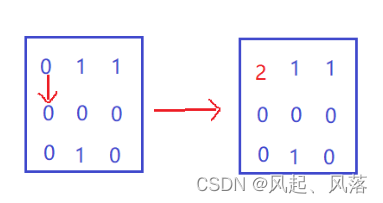
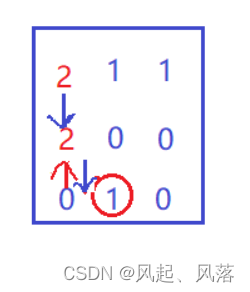
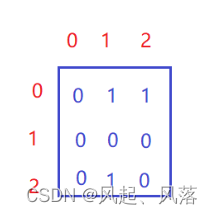


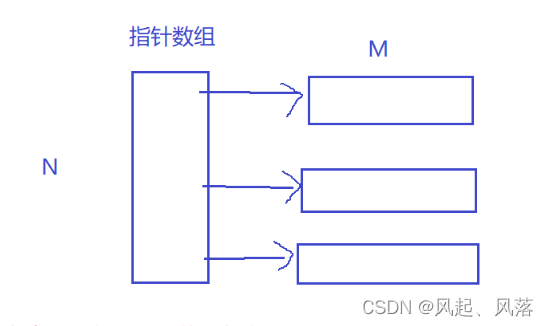

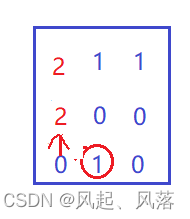










评论